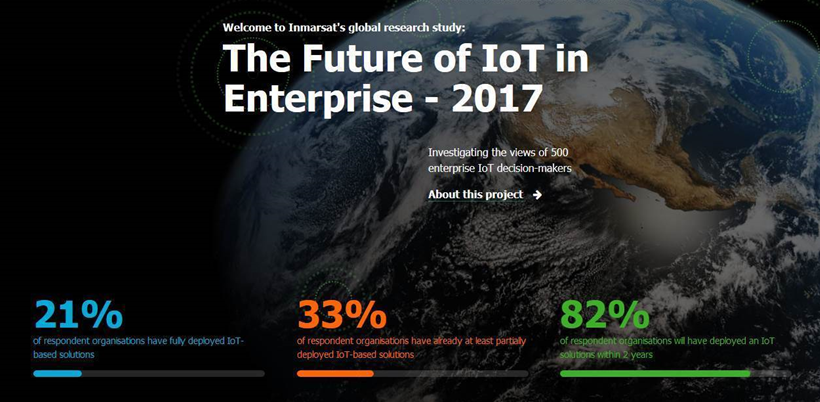IoT is now the lead technology for digital transformation and the number one priority for 92 percent of organisations, according to the results of a global survey commissioned by satellite operator Inmarsat.
The study, which focussed on enterprise applications of IoT, also found machine learning (38 percent of respondents, robotics (35 per cent), and 3D printing (31 percent) to be key requirements for effectively delivering digital transformation for business.
The study identified agriculture as the leading sector for IoT deployment today, followed by transport, energy and mining.
The study asked respondents that were already using IoT for their anticipated future deployment by application. While the level of usage by application — smart monitoring of asset levels employee tracking through wearables, energy consumption monitoring, monitoring product usage, business process automation, smart security management and wide area controls such as vehicle/device management — ranged from 75 percent today (energy usage monitoring) to 12 percent (smart security management) deployments of all were expected to exceed 90 percent within two years.
In February this year Inmarsat entered the IoT market, announcing plans with IoT platform developer Actility to deploy “the world’s first global LoRaWAN network for IoT” by combining its global L-band satellite connectivity with Actility’s ThingPark IoT management platform to interconnect and manage LoRaWAN networks deployed anywhere in the world.
Perhaps not surprisingly, the study identified global connectivity as a key requirement, especially for the energy sector.
“As much as there is to say about the potential IoT holds for the energy sector, concerns around connectivity threaten to hamstring these advances, leaving a significant portion of the energy market unable to capitalise on the transformational capabilities of this technology,” It said.
“Connectivity issues came in as the top concern when deploying IoT solutions for over half. Moreover, around a quarter believe that connectivity issues have the potential to derail the success of their IoT deployments before they’ve even got off the ground.”
For the study, The Future of IoT in Enterprise – 2017, Inmarsat commissioned research company Vanson Bourne to survey 500 senior executives from across the agritech, energy production, transportation and mining sectors, representing organisations over 1,000 employees in size.
Ninety-seven percent said they were experiencing, or expect to experience, significant benefits from the deployment of IoT technologies. Improved service delivery capabilities (47 percent), better health and safety across the organisation (46 percent), and greater workforce productivity (45 percent) were identified as the top three benefits to be gained from the deployment of IoT-based solutions.
Almost half (47 percent) of respondents said their organisation would need to rethink its approach to data security and make heavy investments to meet IoT security requirements. Forty five percent cited lack of skills as a particular challenge for their organisation in deploying IoT.







